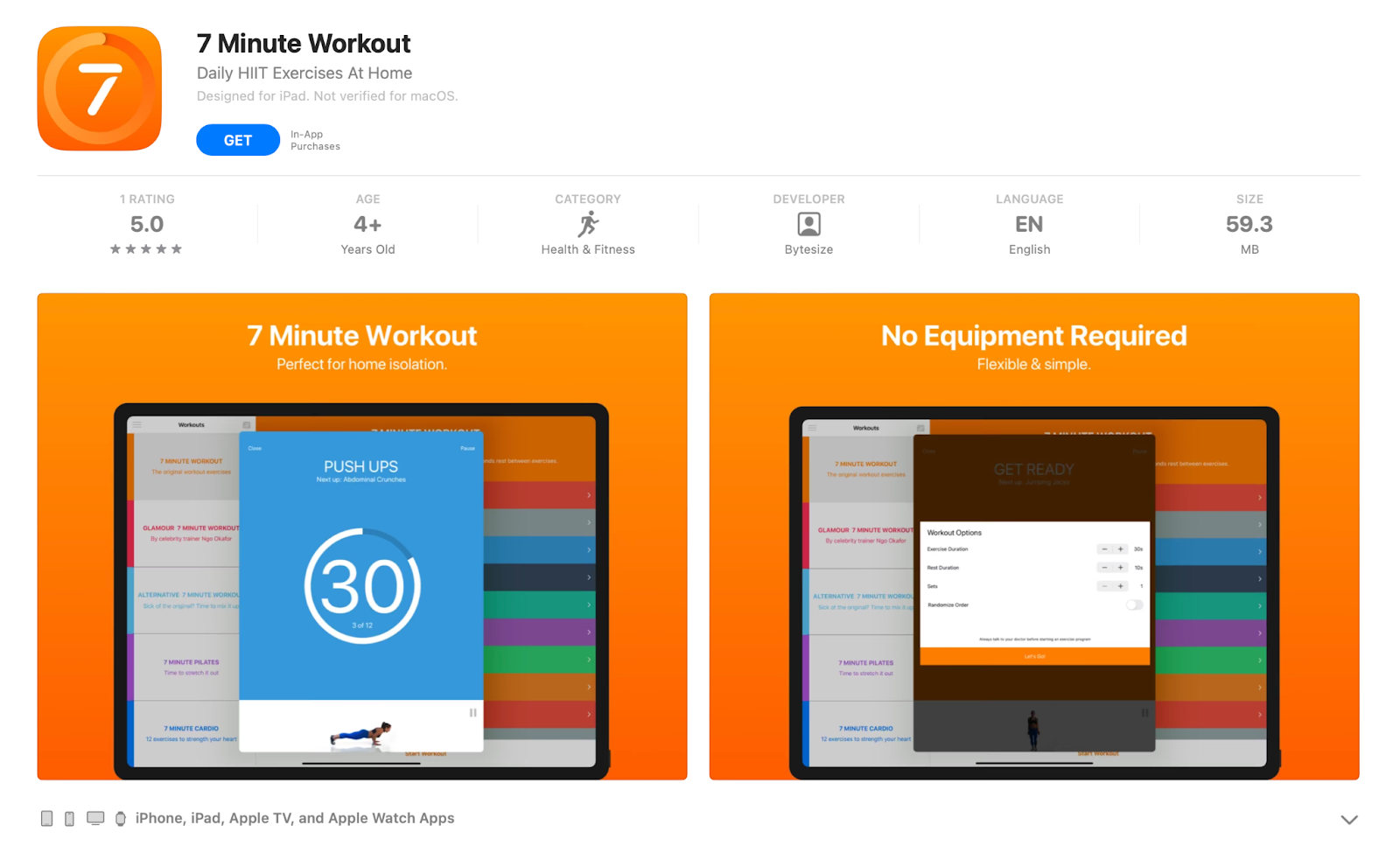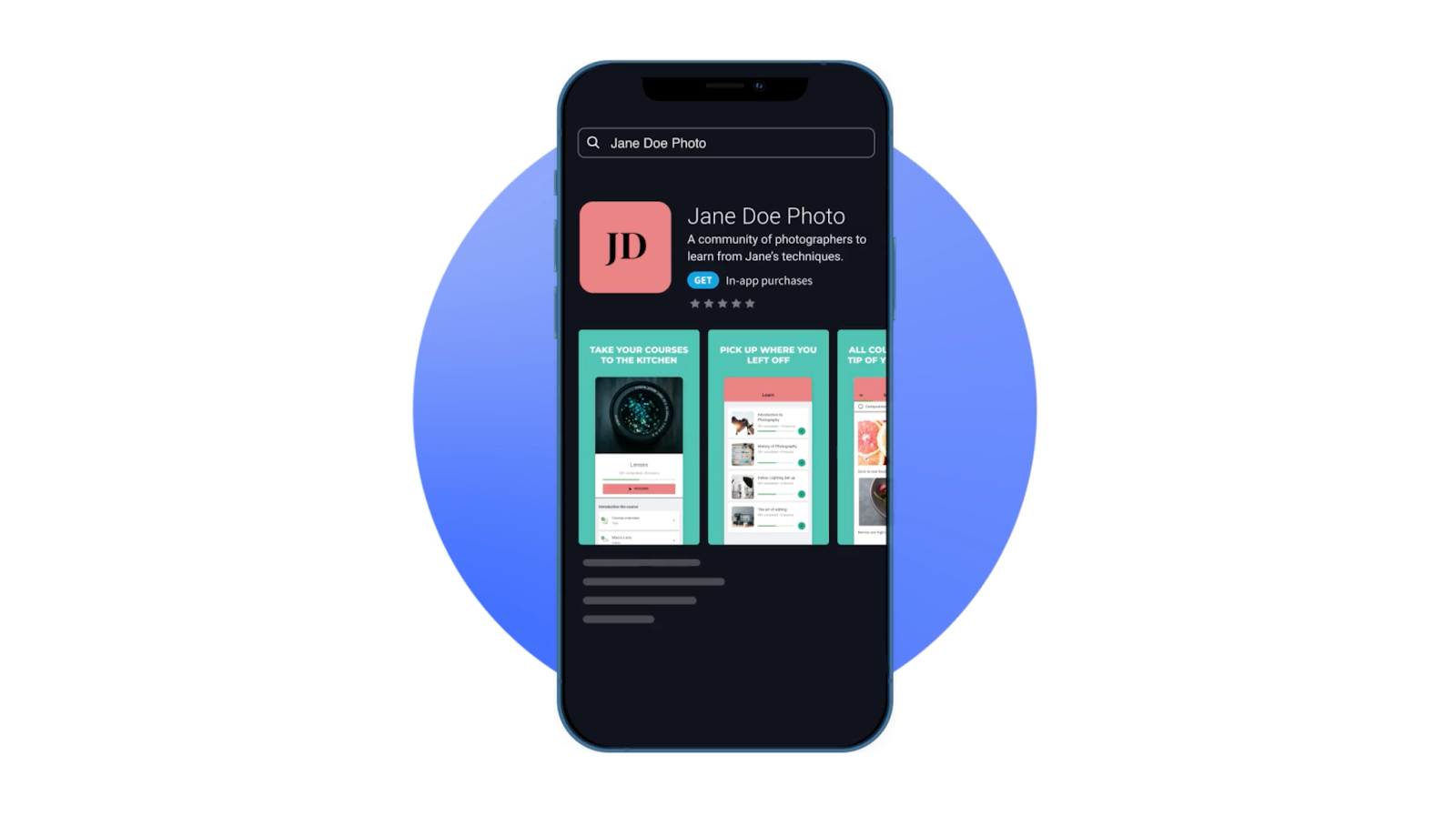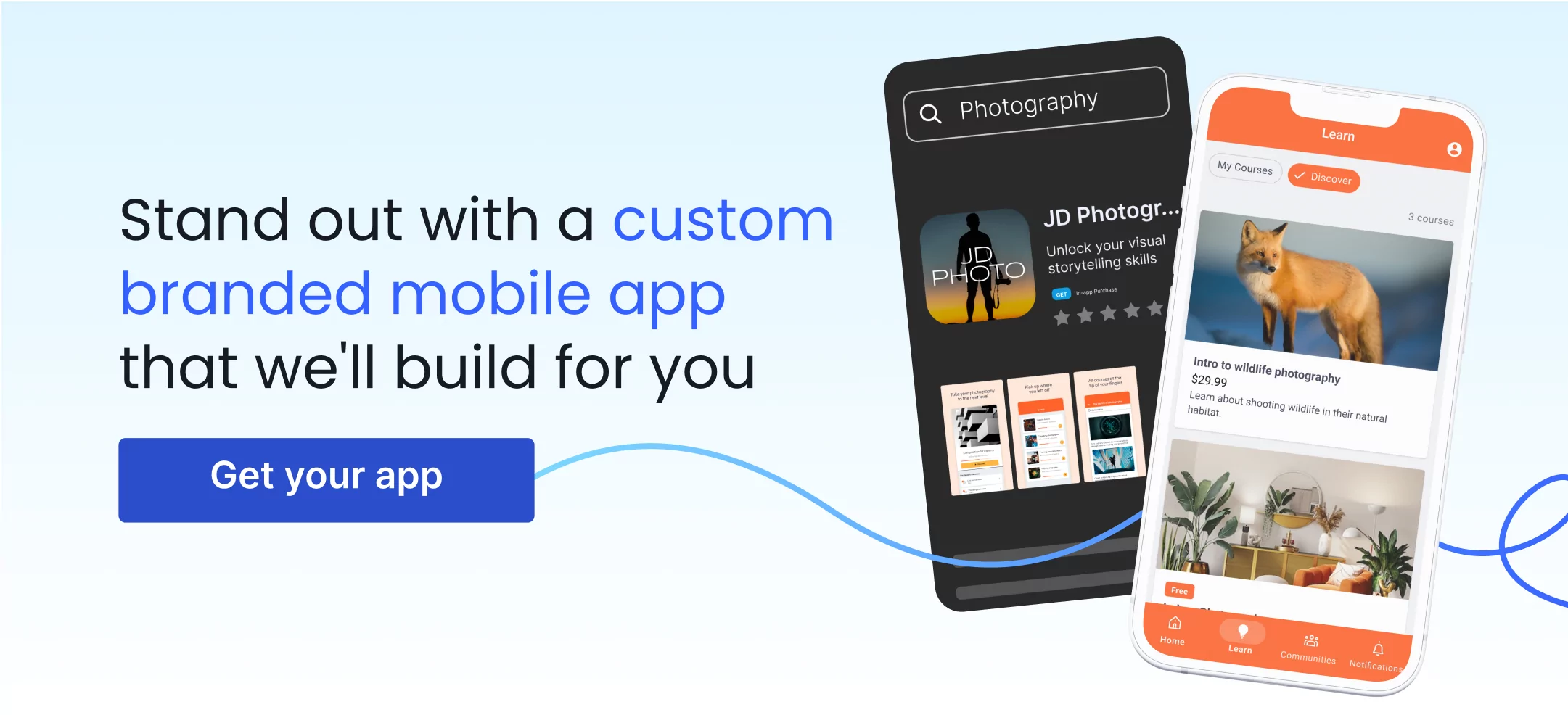Unleashing the power of branded apps for building brand loyalty, backed by research.
As mobile technology continues to permeate every aspect of our lives, branded apps have ascended as a compelling new frontier for building brand loyalty. Companies use branded apps to bring their brand to their audience’s fingertips, deliver a brand-immersive experience across multiple channels, and foster a connection through high-value offerings.
In a competitive digital market, maintaining your brand identity isn’t just a “nice-to-have,” it’s a necessity. As branded apps continue to revolutionize how companies engage with clients, customers, or learners, understanding how to use them can help you build brand loyalty and maximize the return on your investment, while mobile apps are still what users crave.
In this article, we’ll explore several app-relevant definitions and compare branded and unbranded apps. From there, we’ll explore some compelling new research on the role of branded apps in building brand loyalty and share how you can access those benefits without the extraordinarily high cost associated. Let’s get started:
Skip ahead here.
- What is a branded app? And different types of App Branding
- How branded apps build brand loyalty
- The science behind branded apps and brand loyalty
- Thinkific’s Branded Mobile offering
- Your next step to building brand loyalty with branded apps
- FAQs
Related: Branded Mobile vs Thinkific Mobile: What’s Right for Me?
What is a branded app? Different types of app branding.
A branded app is a mobile app that’s developed and promoted by a specific brand. This app prominently features the brand’s identity, including its logo, colors, and other characteristic visual elements. Companies use branded apps to enhance customer engagement, develop brand loyalty, and deliver services, products, or content.
Companies often invest in branded apps because they give companies the ability to interact with and deliver content directly to users’ mobile devices while offering a more personalized experience that reflects the brand’s values, ethos, and style.

Brands like Starbucks, Walmart, and Nike leverage branded apps to engage customers, improve brand recognition, and boost sales.
Starbucks, for example, has seen incredible success with its mobile app, which allows customers to order ahead, pay, and earn rewards for their loyalty. On the app, you can find games, challenges, and even playlists you’ll hear in their café. This makes contact with the brand fast, easy, and engaging.
Nike, another industry-leading example of a branded app, uses its Nike Training Club app to strategically position the brand as a lifestyle and fitness partner. The brand does this by offering high-value content like mindfulness exercises, self-care routines, and at-home workouts for its diverse user base, all while showcasing its products.
While Starbucks and Nike are stellar examples of what a branded app can do for your business, we’re barely scratching the surface. But before we dig further into how branded apps build brand loyalty, there are two additional app “classifications” you should know about—unbranded and white-label apps.
What is an unbranded app?
In contrast to branded apps, unbranded apps are mobile apps designed to deliver a service, product, or digital content without displaying a primary brand.
Examples of unbranded apps include 7 Minute Workout and Smile.io. Smile.io, for example, allows businesses to create loyalty and referral programs for mobile users. However, users may simultaneously engage with multiple brands while using the mobile app.

Often, unbranded apps are a cost-effective alternative to branded apps. The downside to unbranded apps is that they may feature other businesses or don’t prominently feature one brand over another. For companies focused on building brand loyalty, these aren’t always the best tool for your strategy.
Related: What is M Learning? Mobile Learning Pros/Cons & Tips
This brings us to the third and final app style you need to know about.
What is a white-label app?
A white-label app is a generic app developed by one company (the developer) and sold to another (the buyer) so that the purchasing company can rebrand and distribute the app as its own.
White-label apps are a brand-focused alternative to unbranded apps, which makes them a solid choice for companies who want all the benefits of branded apps but the premium price tag or the need to develop an app in-house.
What’s the difference between branded, unbranded, and white-label apps?
Now that we’ve covered branded, unbranded, and white-label apps, let’s look at what makes them different and why companies may choose one over another. Let’s start with what sets these app experiences apart by looking at the in-app experiences of our previous examples.
The Nike Training Club app is a branded app designed for Nike’s target audience. The brand’s name is featured in the app name, the brand’s logo is featured in the app icon, and Nike branding is visible throughout the app, including any video content.
Compare that to 7 Minute Workout. 7 Minute Workout is an unbranded workout app, so it’s not affiliated with any major fitness companies. You won’t notice any Nike, Underarmour, GNC, or other related branding as you use the app.
White-label apps differ because they aren’t technically “branded” or “unbranded” apps. Instead, they blend the best to both.
Good Firms reports that a simple branded app can cost between $12,000 and $30,000, complex apps between $34,000 and $60,000, and advanced apps range from $56,000 to $82,000. In addition to these enormous price tags, simple apps take three to seven weeks, complex apps take eight to 14 weeks, and advanced apps take 13 to 19 weeks to develop.
For a brand like Nike, which spent over $3 billion on advertising in 2022, a $100,000 app is pocket change. But for most businesses, the high price tag and long development commitment behind branded apps make them unattainable, opening the door for unbranded apps.
Unbranded apps are developed and maintained by one business, while its users (different brands) work within the confines of the app to engage with their customers and build loyalty. In a way, unbranded apps can act like a commercial rental space. Following this analogy, retail stores opt to rent a location rather than build it themselves, helping the company avoid certain risks, maintenance costs, and development costs associated with building a brick-and-mortar location.
Although more affordable, unbranded apps give you less control over the platform. In comparison, branded apps give you complete control over every aspect of the user experience. Situated comfortably between these two contrasting experiences are, again, white-label apps.
White-label apps essentially act as a template that other companies can use. Instead of tens of thousands of dollars, brands can pay a fraction of the cost for a fully functional app and still create a brand-specific experience for mobile users, allowing you to enjoy the benefits and perks of branded apps.
How branded apps build brand loyalty
Let’s turn to what you’re here for: building loyalty.
One of the most significant advantages of developing a branded app, shadowing its cons, is the potential to build brand loyalty. This process is both critical and complex for most businesses. So to simplify it, we’ve identified five crucial ways branded apps outperform unbranded apps in developing brand loyalty.
1. Deliver a customized user experience
A powerful benefit of using a branded or white-labeled app is its ability to provide a seamless experience, easy navigation, and attractive and intuitive design without distracting users or diverting their attention to other brands.
Nike Training Club is an excellent example of a branded app tailored to a brand’s target audience, primarily athletes and fitness enthusiasts in Nike’s case. Upon opening the app, users are met with a clean, easy-to-navigate interface. High-quality images subtly reinforce Nike’s brand value—inspiration and innovation for every athlete globally. Nike worked hard to deliver a mobile experience that fit the brand and appealed to its target user.
2. Deliver a personalized user experience
While customized and personalized user experiences may sound similar, they’re different. A customized app experience refers to the global experience your mobile users have. A personalized experience, on the other hand, refers to the specific experience each user has that’s unique to only them.
Branded apps deliver personalized experiences by gathering user data and tailoring content based on preferences. This attention to detail can significantly boost engagement and retention while leaving a lasting impression on users.
To continue building on the Nike Training Club example, as users regularly consume and save certain content, Nike’s app can suggest more and more personalized results under its “Top picks for you” section.
If your app isn’t intended to act as a shop, like in the case of Branded Mobile, then you’ll still be able to track user engagement and analyze metrics for informed decision-making in your business.
3. Offer incentives and rewards
Sure, unbranded apps can offer loyalty and referral programs, but they often do it for multiple brands simultaneously. When you encourage your users to open an app, you probably don’t want them to open a platform that also features their barber, plumber, and fitness instructor.
Branded apps keep the user in an environment that’s entirely dedicated to your brand. So when you reward them for hitting a new goal, accomplishing a task, or making a purchase, they only associate your brand with that positive experience.
4. Build relationships
Like with all relationships, helping users build a relationship with your brand means you have to maintain it. With branded apps, that means utilizing notifications to share about your latest deals or remind them to complete a lesson.
Remember the last time Snapchat reminded you of your dying streak or Dualingo reminded you to keep your learning going? Push notifications are an effective way to get users to return to the app. Branded apps give you more control over when and to whom you send notifications and what they look like.
In addition to notifications, branded apps build brand loyalty by allowing you to collect feedback and offer support. Feedback is essential in assessing the performance of your app. Is it meeting user expectations? The best way to find out is to ask the user directly. Adding support to your mobile offering repertoire will also give you more touch points with customers, helping you keep them satisfied and happy in their brand experience.
5. Build an omnichannel customer experience
An omnichannel customer experience is an experience that creates multiple touchpoints for customers, clients, or learners. Further, customers should be able to start a task on one channel and pick up where they left off on another.
In an e-commerce context, a consumer who adds shoes to their cart while waiting at the Doctor’s office should be able to log into their laptop at home and continue shopping without missing a beat. For online course creators, learners should be able to start a lesson on their office desktop and finish it on their phone from an Uber.
Starting to see why branded and white-label apps appeal to so many businesses? Seamless connectivity and transitions are expected more and more by consumers. Providing that smooth experience will enhance the user experience, build trust, and increase brand loyalty.
To recap, branded apps help you:
- Deliver customized experiences
- Deliver personalized experiences
- Offer incentives and rewards, encouraging loyalty
- Build relationships with mobile users
- Build a seamless omnichannel customer experience
But don’t just take our word for it. Let’s look at what the science has to say about branded apps and building brand loyalty.
The science behind branded apps and brand loyalty
In 2022, Daria Plotkina and Landisoa Rabeson published an article titled “The role of transactionality of mobile branded apps in brand experience and its impact on loyalty.” This research sought to better understand how branded, non-transactional apps influence brand loyalty. The results? Profound.
Insights from the Journal of Brand Management’s study on branded apps
We’ve extracted three of its most valuable findings to save you from reading the dense 14-page article. But first, here’s a bit of meaningful context.
Plotkina and Rabeson present some eye-opening insights into how app users perceive branded apps. However, before they present their findings, they highlight that consumers consider free apps to be more interesting, attractive, and novel compared to apps with a price tag. That means consumers value non-transactional apps more than semi-transactional (think freemium) or transactional apps.
With this in mind, they went into their research hypothesizing that free branded apps will generate more brand loyalty than transactional apps by facilitating more brand personality, satisfaction, and identification—spoiler alert, they were right.
Now, onto the key findings.
1. An new definition of branded apps
We defined branded apps at the beginning of this article. Still, it’s helpful to understand how others define the term.
Plotkina and Rabeson use the following definition: “software downloadable to a mobile device that clearly displays a brand identity via the name of the app and the appearance of a brand logo throughout the user experience.”
They also note that the ultimate goal of a branded app is to create brand loyalty, which is defined as “the tendency to be loyal to a focal brand, which is demonstrated by the intention to buy the brand as a primary choice.” This means building brand loyalty can significantly affect your key performance indicators (KPIs); increased brand loyalty will increase customer lifetime value (CLV) and return on investment (ROI) while decreasing the customer acquisition cost (CAC).
Related: Customer Success Metrics and KPIs
2. Brand identification as a new mediator between brand experience and loyalty
Plotkina and Rabeson found that brand identification acts as a formerly undiscovered mediator between brand experience and brand loyalty.
They claim, “Specifically, the results of laboratory and field experiments show that the creation of brand identification is an effective way to trigger brand loyalty after experiences with branded mobile apps.”
To be clear, brand identification in this context is not referring to how consumers or users identify your brand— like when you spot the Swoosh logo and recognize it as Nike. Instead, brand identification refers to how consumers identify with your brand.
The Nike Training Club app should focus on activity as Nike’s consumers are generally active. This will help its active users identify with the brand.
So what does this mean for you? It means you can develop and maintain brand identification through branded apps, a now-proven method for creating brand loyalty.
3. The effect of sporadic app use on personal bonding with the brand
Thankfully, users don’t have to be constantly engaged for you to foster and boost brand loyalty. Plotkina and Rabeson found that even sporadic app usage increases personal bonds with the brand, further reinforcing brand loyalty. The driving force behind this increase in loyalty is the intimacy that comes with the app’s permanent residence on your user’s mobile device.
In their own words, “…having an app on one’s smartphone and using it even sporadically increases the personal relationship and bond with the app, as it ‘lives’ on the screen of one’s closest ally.”
The two researchers also found the quality of content users find once inside is more important than how frequently they open your app. They discovered that free content should be “very” high quality, something many marketers, developers, and other stakeholders already strive for.
Suppose your branded mobile app does allow for some degree of transactionality. In that case, consumers should see that transaction as a way to improve their experience rather than viewing it as a commercial transaction—which, again, emphasizes value and quality.
Additional insights
The research underscores that non-transactional mobile apps bolster brand loyalty significantly more than transactional apps. In other words, in the eyes of a consumer, mobile apps need to be about more than a means for commercial transactions. For companies looking to build brand loyalty, that means they should focus on creating brand identification and satisfaction through new experiences, like in a branded app.
Nike has come up a lot in this article—for good reason. Nike has proven they understand the role of transactionality in mobile apps. The research goes so far as to recommend the Nike approach, stating, “Other companies may follow Nike’s example and provide non-transactional and semi-transactional apps. This is already the case for its direct competitors.” They go on to reference Rebook and Adidas strategies that mimic Nike’s.
As for actionable advice you can bring to your teams, “The developers and marketers should make sure that there is a low bounce rate and that consumers do not uninstall the app.” A bad experience with your mobile app will not lead to brand satisfaction or identification and will impede that user’s journey to brand loyalty.
The implications of this research are clear: loyalty drives customer lifetime value and, by extension, a return on your investment in customer acquisition. Regardless of your app’s purpose, whether transactional, semi-transactional, or non-transactional, the ultimate goal should be to create positive user experiences, which will boost brand loyalty.
Thinkific’s Branded Mobile offering
Like Nike’s competitors, more and more businesses recognize the value of branded apps. Plotkina and Rabeson couldn’t have said it better, “Branded apps are gaining momentum in branding strategies, as they allow proximity to the customers and a great opportunity to engage and retain them.”
It’s clear these high-value apps help to build, boost, and maintain customer engagement and loyalty. However, as we discussed earlier, developing a branded app from the ground up can cost tens of thousands of dollars and take months of your time. Such a heavy investment is often prohibitive for most companies, especially smaller enterprises and startups.
Enter white-label apps. They empower businesses to deliver branded experiences personalized to their audience without the investment branded apps require.
At Thinkific, we believe in the power of a high-value high-quality branded experience. That belief led us to launch Branded Mobile, a white-labeled app custom-built for your brand without the premium price tag.
Features and benefits of Branded Mobile
As the first of its kind in our industry, Branded Mobile has a lot to offer. So, here are five of the benefits of Branded Mobile we think you’ll find extremely valuable.
New revenue opportunities
With Branded Mobile, you can allow your users to continue their learning journey with its innovative in-app purchase feature. This allows your audience to effortlessly purchase supplementary courses and continue consuming your content all from within your app. By eliminating the need to navigate away from the app, Branded Mobile ensures uninterrupted engagement and a fluid transition from discovery to purchase, ultimately driving additional revenue.
We’ll build it for you
Our trusted team of experts at Thinkific will take care of creating and managing your white-labeled app so you can focus on your business. Unlike building a custom app from scratch, where extensive time and money is required to build, not to mention maintain, Thinkfiic will handle building, submitting your app and delivering frequent updates, all for $199/mo.
Your brand shines
Branded Mobile allows your business to deliver an immersive branded experience. Your logo, brand colors, and other visual elements aren’t just “featured,” they’re integrated throughout the entire user experience. For your students, that experience begins when they view your custom listing in iOS and Android app stores and download your branded app. But it doesn’t stop there.
Flexibility
The intimacy a branded app creates between your brand and learners is unparalleled. With Branded Mobile, you can deliver an intuitive and easy-to-use platform right to your learners’ fingertips, demonstrating respect for their lifestyle and strengthening the bond between your brand and your students.
Branded Mobile is also designed to seamlessly integrate into your audience’s existing routines. This alignment makes it easier for users to learn and engage with their courses and communities all on their own schedule, enhancing their learning and brand experience.
Better connection
One of the most powerful features of Branded Mobile is its potential to foster a stronger connection with your users and for users to develop a sense of community and belonging. Branded Mobile gives your content the advantage of being accessible anywhere, anytime. And with a feature like push notifications, you serve up gentle reminders, keeping your brand fresh in your learners’ minds.
Additionally, Branded Mobile doesn’t just bring your educational content to the mobile experience; it gives students access to communities. Your students will have direct access to your community spaces, the ability to post, comment, and reply, and so much more. With constant access to their peers, users can enjoy the vibrant community atmosphere, furthering their engagement. This level of connection deepens the relationship with your brand and the sense of loyalty you’ve already started to build.
“In short, developing and maintaining brand identification through experience with branded apps helps consumers consider the brand as their long-term companion. Thus, consumers have a profound bond with the brand, which can benefit their loyalty intentions.”Daria Plotkina and Landisoa Rabeson, Journal of Brand Management

Notifications and in-app components will reflect your brand’s visual identity. Such a unique, unified presentation will build brand recognition and trust amongst your users. And in time, that trust will grow into brand loyalty.
Read more: Maximize your brand potential with the Branded Mobile app
Your next step to building brand loyalty with branded apps
Branded apps have emerged as a powerful tool for building brand loyalty. It’s no surprise that more and more companies are looking to invest in them as a proven way to reach and consistently engage their audience.
The key to a successful branded or white-labeled app lies in the value you provide. Your goal should be to produce user-focused, high-quality, high-value content. Ready to add a mobile app to your toolkit? Discover how Branded Mobile, a white-labeled app solution, can help you build brand loyalty without the premium price or the need for technical expertise associated with branded apps.
To learn more about how Thinkific’s Branded Mobile can revolutionize how you engage your learners, request a call. Our team is ready to help answer your burning questions and help you on your path to launching a branded app.
FAQs
What is the difference between branded and unbranded apps?
The difference between branded and unbranded apps lies in their purpose and design. Branded apps are used by businesses to provide a unique user experience that fosters positive brand identification and satisfaction, ultimately building brand loyalty. On the other hand, unbranded apps, while functional, don’t always offer the level of customization needed to reflect your brand’s identity.
What are some branded app examples?
Some excellent examples of branded apps include Nike’s suite of apps. Some of the brand’s most well-known apps include Nike, Nike Training Club, and Nike Run Club. Both club apps offer a blend of transactional and non-transactional features aligned with the brand’s offerings and personality. Competing brands like Adidas and Reebok have followed Nike’s lead and developed their own branded apps. Other examples include Starbucks, Walmart, Walgreens, and Quizlet.
How can companies build brand loyalty?
Companies can create brand loyalty by offering highly valuable, high-quality content and regularly engaging users through channels like mobile apps. In particular, branded apps can help companies foster brand identification and satisfaction, both of which play critical roles in brand loyalty.







